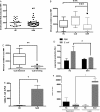Defective monocyte oxidative burst predicts infection in alcoholic hepatitis and is associated with reduced expression of NADPH oxidase
- PMID: 26860769
- PMCID: PMC5534772
- DOI: 10.1136/gutjnl-2015-310378
Defective monocyte oxidative burst predicts infection in alcoholic hepatitis and is associated with reduced expression of NADPH oxidase
Abstract
Objective: In order to explain the increased susceptibility to serious infection in alcoholic hepatitis, we evaluated monocyte phagocytosis, aberrations of associated signalling pathways and their reversibility, and whether phagocytic defects could predict subsequent infection.
Design: Monocytes were identified from blood samples of 42 patients with severe alcoholic hepatitis using monoclonal antibody to CD14. Phagocytosis and monocyte oxidative burst (MOB) were measured ex vivo using flow cytometry, luminometry and bacterial killing assays. Defects were related to the subsequent development of infection. Intracellular signalling pathways were investigated using western blotting and PCR. Interferon-γ (IFN-γ) was evaluated for its therapeutic potential in reversing phagocytic defects. Paired longitudinal samples were used to evaluate the effect of in vivo prednisolone therapy.
Results: MOB, production of superoxide and bacterial killing in response to Escherichia coli were markedly impaired in patients with alcoholic hepatitis. Pretreatment MOB predicted development of infection within two weeks with sensitivity and specificity that were superior to available clinical markers. Accordingly, defective MOB was associated with death at 28 and 90 days. Expression of the gp91 phox subunit of nicotinamide adenine dinucleotide phosphate (NADPH) oxidase was reduced in patients with alcoholic hepatitis demonstrating defective MOB. Monocytes were refractory to IFN-γ stimulation and showed high levels of a negative regulator of cytokine signalling, suppressor of cytokine signalling-1. MOB was unaffected by 7 days in vivo prednisolone therapy.
Conclusions: Monocyte oxidative burst and bacterial killing is impaired in alcoholic hepatitis while bacterial uptake by phagocytosis is preserved. Defective MOB is associated with reduced expression of NADPH oxidase in these patients and predicts the development of infection and death.
Keywords: ALCOHOLIC LIVER DISEASE; BACTERIAL INFECTION; IMMUNOLOGY IN HEPATOLOGY.
Published by the BMJ Publishing Group Limited. For permission to use (where not already granted under a licence) please go to http://www.bmj.com/company/products-services/rights-and-licensing/.
Conflict of interest statement
Figures







Similar articles
-
Monocyte/macrophage-specific NADPH oxidase contributes to antimicrobial host defense in X-CGD.J Clin Immunol. 2015 Feb;35(2):158-67. doi: 10.1007/s10875-015-0138-4. Epub 2015 Feb 10. J Clin Immunol. 2015. PMID: 25666294
-
Induction of antimicrobial pathways during early-phase immune response to Salmonella spp. in murine macrophages: gamma interferon (IFN-gamma) and upregulation of IFN-gamma receptor alpha expression are required for NADPH phagocytic oxidase gp91-stimulated oxidative burst and control of virulent Salmonella spp.Infect Immun. 2003 Aug;71(8):4733-41. doi: 10.1128/IAI.71.8.4733-4741.2003. Infect Immun. 2003. PMID: 12874355 Free PMC article.
-
NF-kappaB regulates phagocytic NADPH oxidase by inducing the expression of gp91phox.J Biol Chem. 2006 Mar 3;281(9):5657-67. doi: 10.1074/jbc.M506172200. Epub 2006 Jan 5. J Biol Chem. 2006. PMID: 16407283
-
Role of plant respiratory burst oxidase homologs in stress responses.Free Radic Res. 2018 Aug;52(8):826-839. doi: 10.1080/10715762.2018.1473572. Epub 2018 Jul 3. Free Radic Res. 2018. PMID: 29732902 Review.
-
Neutrophils to the ROScue: Mechanisms of NADPH Oxidase Activation and Bacterial Resistance.Front Cell Infect Microbiol. 2017 Aug 25;7:373. doi: 10.3389/fcimb.2017.00373. eCollection 2017. Front Cell Infect Microbiol. 2017. PMID: 28890882 Free PMC article. Review.
Cited by
-
Early loss of T lymphocyte 4-1BB receptor expression is associated with higher short-term mortality in alcoholic hepatitis.PLoS One. 2021 Aug 5;16(8):e0255574. doi: 10.1371/journal.pone.0255574. eCollection 2021. PLoS One. 2021. PMID: 34352016 Free PMC article.
-
Acute-on-chronic liver failure: far to go-a review.Crit Care. 2023 Jul 1;27(1):259. doi: 10.1186/s13054-023-04540-4. Crit Care. 2023. PMID: 37393351 Free PMC article. Review.
-
Infection does not increase long-term mortality in patients with acute severe alcoholic hepatitis treated with corticosteroids.World J Gastroenterol. 2017 Mar 21;23(11):2052-2059. doi: 10.3748/wjg.v23.i11.2052. World J Gastroenterol. 2017. PMID: 28373772 Free PMC article.
-
Biomarkers of Macrophage Activation and Immune Danger Signals Predict Clinical Outcomes in Alcoholic Hepatitis.Hepatology. 2019 Oct;70(4):1134-1149. doi: 10.1002/hep.30617. Epub 2019 May 27. Hepatology. 2019. PMID: 30891779 Free PMC article.
-
Altered bioenergetics and mitochondrial dysfunction of monocytes in patients with COVID-19 pneumonia.EMBO Mol Med. 2020 Dec 7;12(12):e13001. doi: 10.15252/emmm.202013001. Epub 2020 Nov 5. EMBO Mol Med. 2020. PMID: 33078545 Free PMC article.
References
-
- Maddrey WC, Boitnott JK, Bedine MS, et al. . Corticosteroid therapy of alcoholic hepatitis. Gastroenterology 1978;75:193–9. - PubMed
MeSH terms
Substances
Grants and funding
LinkOut - more resources
Full Text Sources
Other Literature Sources
Medical
Research Materials
Miscellaneous
